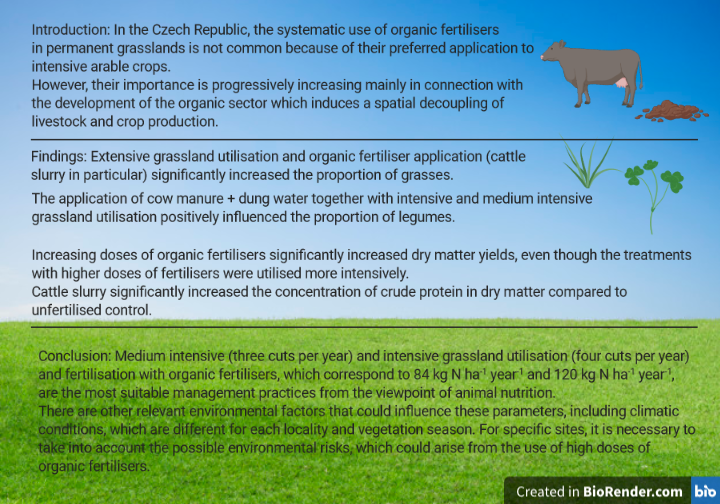Preprint
Article
The Effect of Organic Fertilisers on the Floristic Composition of Grassland, Herbage Yield and Quality
Altmetrics
Downloads
321
Views
181
Comments
0
This version is not peer-reviewed
Submitted:
17 August 2020
Posted:
18 August 2020
You are already at the latest version
Alerts
Abstract
The aim of this study was to assess the effects of organic fertilisers (cow manure + dung water; cattle slurry) applied in different annual doses of nitrogen (54 kg ha-1; 84 kg ha-1; 120 kg ha-1) according to 3 different intensities of grassland utilisation (extensive – 2 cuts per year, medium intensive – 3 cuts per year, intensive – 4 cuts per year) on percentage of plant functional groups (grasses, legumes, forbs), dry matter yield, and forage quality. The study was performed as a small-plot trial over 7 years on moderately moist grassland in the Czech Republic. The proportion of legumes was significantly higher in the fertilisation treatments with cow manure + dung-water combined with medium intensive utilisation and intensive utilisation (10.2% and 10.3%, respectively). Fertilisation significantly increased dry matter yields by 51.9 % (cow manure + dung water) and 56% (cattle slurry) compared to unfertilised controls (4.81 t ha-1). Grasslands fertilised with cattle slurry showed significantly higher concentration of crude protein (142.9 g kg-1) than unfertilised (126.4 g kg-1). Extensive grassland utilisation significantly increased crude fibre concentration (up to 282.1 g kg-1), and decreased the energy value (up to 4.68 MJ kg-1 of NEL). Organic matter digestibility was negatively influenced by extensive grassland utilisation (61.0%, 65.42 % and 67.44% for the extensive, medium intensive and intensive utilisation, respectively). Our findings suggest that medium intensive and intensive grassland utilisation using organic fertilisation which correspond to annual doses of nitrogen of 84 kg ha-1 and 120 kg ha-1, are the most suitable for animal nutrition.

Keywords:
Subject: Biology and Life Sciences - Plant Sciences
Copyright: This open access article is published under a Creative Commons CC BY 4.0 license, which permit the free download, distribution, and reuse, provided that the author and preprint are cited in any reuse.
MDPI Initiatives
Important Links
© 2024 MDPI (Basel, Switzerland) unless otherwise stated




